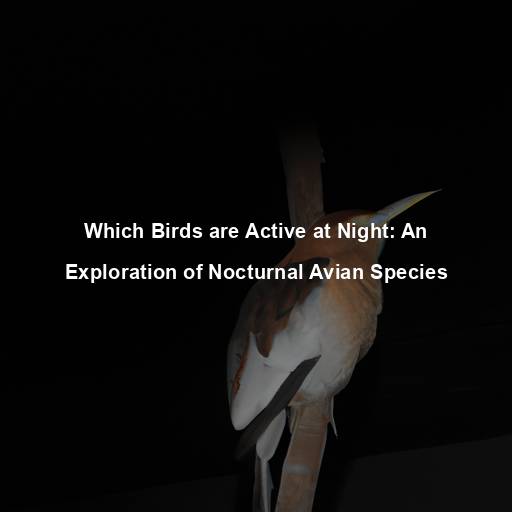The Fascinating World of Birds: How Do They Fly?
Last Updated on October 22, 2023 by Evan
Contents [hide]
- 1 The Wonders of Avian Flight
- 1.1 Understanding the Basics: Anatomy and Physiology
- 1.2 The Mechanics of Flight: Lift, Thrust, Drag, and Gravity
- 1.3 Different Flight Techniques: Soaring, Gliding, and Flapping
- 1.4 The Role of Instinct and Learning in Bird Flight
- 1.5 Unlocking the Secrets of Flight: Ongoing Research and Discoveries
- 1.6 Awe-Inspiring and Enigmatic: The Magic of Bird Flight
- 1.7 Biomechanics: Unlocking the Secrets of Bird Wings
- 1.8 Flight Patterns: From Migratory Routes to Aerial Acrobatics
- 1.9 Aerodynamics: The Science Behind Bird Flight
- 1.10 Flight Evolution: Tracing the Origins of Avian Flight
- 1.11 Flight Performance: Pushing the Limits of Avian Flight
- 1.12 Flightless Birds: The Exception to the Rule
- 1.13 The Future of Avian Flight Research
- 2 Appreciating the Wonders of Bird Flight
- 3 FAQs – How Do Birds Fly
The Wonders of Avian Flight
Throughout the annals of time, humans have been mesmerized by the bewitching allure of birds, their mastery of the heavens, and the enigmatic splendor of their celestial ballet. Whether it be the regal eagle, effortlessly gliding with regal poise amidst the majestic mountains, or the exquisite hummingbird, ethereally suspended in mid-air, transfixed by a delicate flower, birds possess an uncanny knack for navigating the vast expanses of the sky with unrivaled grace. It is a bewilderment that has fueled our curiosity for ages – how do these feathery creatures accomplish such a remarkable feat? This article will endeavor to unravel the intricate mechanics behind avian flight, delving deep into the inexplicable secrets that allow birds to conquer the boundless firmament.
Understanding the Basics: Anatomy and Physiology
Before we can comprehend the intricacies of bird flight, it is essential to understand the unique adaptations that enable these feathered creatures to conquer the skies. Birds possess a number of specialized anatomical features that are specifically designed for flight. Let’s take a closer look at some of these remarkable adaptations:
Feathers, oh feathers! They’re the enchanting essence that sets birds apart from the rest of the animal kingdom. These ethereal structures hold the magic of flight, propelling our feathered friends through the open skies. It’s the intricate dance between the arrangement and structure of these feathers that unlocks the secrets of avian aviation.
Delicate and yet remarkably sturdy, birds possess a fascinating anatomical feature – hollow bones. These extraordinary skeletal structures serve a dual purpose, acting as both a weight-reducing mechanism and a means to enhance their buoyancy. Such intricate adaptations afford these feathered creatures the ability to gracefully navigate the skies while effortlessly withstanding the forces exerted upon them during flight. A remarkable example of nature’s ingenuity, this unique attribute contributes to the avian marvel’s unparalleled aerial dexterity.
Take flight with the astonishing might of avian muscle power! The secret behind birds’ gravity-defying abilities lies in their robust flight muscles. These extraordinary muscles, found in the breast area, generate the awe-inspiring flapping motion that propels these winged creatures through the skies. Prepare to be enthralled by the awe-inspiring might of their pectoral muscles, specially adapted for the art of flight.
The Mechanics of Flight: Lift, Thrust, Drag, and Gravity
When birds defy gravity and take flight, a captivating dance between the principles of aerodynamics unfolds. In this enchanting spectacle, four forces gracefully intertwine to propel our feathered friends through the skies. We embark on a mesmerizing journey to decipher the secret language of birds in motion, as we unravel the intricate ballet of lift, thrust, drag, and gravity. Prepare to be amazed as we delve into the enchanting world of avian aerodynamics.
Soaring through the vast expanse of the sky, birds defy the laws of gravity with their mysterious power of levitation. How, you may wonder, do these magnificent creatures achieve this mesmerizing feat? The secret lies in the intricate interplay between their wings and the invisible currents of air that surround them. With a gentle curve and a delicate balance, these enigmatic appendages create a symphony of pressure differentials, carving a path for the mystical force known as lift.
-
Thrust: Thrust is the forward force that propels birds through the air. It is produced by the flapping motion of their wings, which generates a combination of lift and forward momentum. By tilting and adjusting the shape of their wings during the flapping cycle, birds can control the direction and speed of their flight.
-
Drag: Drag is the resistance encountered by birds as they move through the air. It is caused by the friction between the bird’s body and the surrounding air molecules. To minimize drag and optimize their flight efficiency, birds have streamlined bodies and feathers that reduce turbulence and air resistance.
-
Gravity: Gravity is the force that pulls objects, including birds, toward the Earth’s surface. Birds must continually generate lift and thrust to counteract the effects of gravity and remain airborne. By adjusting their wing movements and body position, birds can regulate their altitude and maintain stable flight.
Different Flight Techniques: Soaring, Gliding, and Flapping
From the elegant soaring of the majestic albatross to the fast-paced flapping of the hummingbird’s delicate wings, the avian world never ceases to leave us in awe. Join us as we embark on a journey to unravel the mysteries behind the mesmerizing flight techniques of our feathered friends. Prepare to be mesmerized by the burst of energy in the agile wings of the hummingbird, the effortless gliding of the albatross, and the perplexing aerial acrobatics of the falcon. Brace yourself for a delightful dive into the captivating world of avian flight!
Gazing up at the sky, one can witness the majestic dance of soaring birds. With an uncanny ability to harness the power of thermals and updrafts, these magnificent creatures effortlessly traverse the heavens. Through this captivating technique, birds like eagles and vultures embark on daring journeys, spanning vast distances and granting them an intimate knowledge of their territory. It is a mesmerizing marvel of nature, revealing the intricate balance between strength, grace, and the boundless mysteries of flight.
- Gliding: Gliding is a form of flight employed by birds with long, broad wings, such as albatrosses and frigatebirds. These birds use their wings to catch the wind and remain airborne for extended periods with minimal wing flapping. Gliding enables them to traverse vast stretches of open ocean or cover great distances during migration.
When it comes to avian flight, one cannot overlook the captivating flapping, a truly awe-inspiring form of flight. The mesmerizing sight of birds swiftly beating their wings is not only a testament to their graceful movement, but also their ability to generate lift and propulsion. This characteristic enables them to navigate the skies with unparalleled precision, executing impressive maneuvers and even hovering effortlessly. An enchanting example of this is the breathtaking performance of hummingbirds, whose rapid wing beats showcase their extraordinary agility and mastery of flapping flight.
The Role of Instinct and Learning in Bird Flight
While birds possess innate flight instincts, their ability to fly is not entirely predetermined. Young birds undergo a learning process known as fledging, during which they gradually develop their flying skills under the guidance of their parents. Fledglings start with short flights, gradually building up strength and coordination until they are fully capable of sustained flight. This learning process ensures that the intricate techniques and maneuvers required for successful flight are passed down from one generation to the next.
Unlocking the Secrets of Flight: Ongoing Research and Discoveries
Bird flight has long captivated scientists, yet the enigmatic nature of this aerial prowess eludes full comprehension. Despite tireless scrutiny of avian wings and meticulous tracking of flight trajectories, the perplexities remain. Futuristic investigations, empowered by revolutionary imaging methodologies, hold promise for unraveling the secrets of avian flight and uncovering the hidden whispers of their biomechanical marvels. Scientists, armed with unyielding curiosity and relentless innovative spirit, aim to penetrate the deep complexities of this winged enigma, stretching the boundaries of our knowledge.
Awe-Inspiring and Enigmatic: The Magic of Bird Flight
Few natural spectacles compare to the sheer wonder of bird flight. Against all odds, these fascinating creatures effortlessly conquer gravity and traverse vast distances with unwavering precision. With each new breakthrough in scientific research, we find ourselves increasingly captivated by the intricate mechanics behind their airborne exploits. From the graceful glide of an eagle to the melodious symphony of a songbird, it is impossible not to be both humbled and astounded by how these winged marvels have truly embraced the art of soaring.
Scientists and researchers have dedicated countless hours to studying bird flight, employing various methodologies to gain a deeper understanding of this fascinating phenomenon. Let’s explore some of the groundbreaking studies and discoveries that have shed light on the intricacies of avian flight.
Biomechanics: Unlocking the Secrets of Bird Wings
Delving into the enigmatic world of avian flight mechanics, scientists have embarked on a trailblazing journey to decode the intricate web that comprises the wings of birds. Armed with cutting-edge technologies like high-speed cameras and X-ray imaging, these intrepid researchers have uncovered a mesmerizing tapestry of wing motions in flight. With each revelation, they have unearthed the hidden symphony of wing beats, the elegant dance of wing joints, and the awe-inspiring aerial acrobatics as birds fine-tune their flight prowess with meticulous precision.
Flight Patterns: From Migratory Routes to Aerial Acrobatics
The mesmerizing world of bird flight has long captivated scientists, who have entered the realm of tracking these feathered wanderers to unravel the mysteries of their astonishing navigation skills and airborne rituals. From high-tech satellite gadgets and radar wizardry to the enthusiastic participation of dedicated citizen scientists, a tapestry of research endeavors has emerged. This enchanting journey into the vast skies has unveiled the enigmatic puzzle of long-distance migrations, the enchanting formation of V-shaped flocks, and the dizzying whirls and twirls exhibited by birds during their courtship escapades. Prepare to be astounded as we delve into the captivating realm of avian exploration.
Aerodynamics: The Science Behind Bird Flight
Bird flight is full of fascinating mysteries that scientists have tirelessly explored. Through a series of intricate experiments, researchers have delved into the mesmerizing world of aerodynamics. By employing cutting-edge wind tunnels, they have unraveled the intricate dance between birds and the forces that govern their flight. These groundbreaking investigations have shed light on the secrets of airflow patterns, the art of wing shape optimization, and the delicate interplay between wing morphology and flight efficiency.
Flight Evolution: Tracing the Origins of Avian Flight
For centuries, the enigmatic allure of how birds came to conquer the skies has captivated the curious minds of scientists. Deep in the annals of paleontology, a treasure trove of extraordinary fossils has unveiled a captivating narrative that unravels the perplexing story of avian flight. Embodied by the ancient remains of the awe-inspiring Archaeopteryx, a long-lost creature that bridges the gap between dinosaurs and modern birds, these astonishing discoveries have illuminated the gradual emergence of flight-related adaptations. Unraveling the fossil record, intrepid scientists have painstakingly dissected anatomical features, assembling a breathtaking mosaic that traces the evolutionary odyssey culminating in the astounding diversity of bird species we bear witness to today.
Flight Performance: Pushing the Limits of Avian Flight
Birds exhibit an astounding range of flight capabilities, from the soaring heights of raptors to the nimble maneuvers of hummingbirds. To understand the limits of avian flight, researchers have investigated the extreme flight performances of different bird species. Studies have examined the maximum speeds birds can achieve, the endurance of long-distance migrants, and the aerodynamic challenges faced by birds in different ecological habitats. These investigations provide valuable insights into the remarkable adaptability and versatility of birds in the air.
Flightless Birds: The Exception to the Rule
In the vast kingdom of birds, it is mesmerizing to discover the exceptions that defy the norm. While flight comes instinctively to most birds, there exists a captivating realm where creatures like penguins, ostriches, and kiwis reign as flightless marvels. These remarkable beings have undergone extraordinary adaptations that help them thrive within their distinctive habitats, untouched by the allure of soaring through the skies. In the depths of scientific exploration, researchers eagerly unravel the intricate story behind the loss of flight, meticulously dissecting the anatomical wonders and unraveling the enigmatic behavioral tactics of these avian anomalies.
The Future of Avian Flight Research
With the continuous advancement of technology, the world of avian flight research is being catapulted into an exciting and promising future. Embracing the complexities of this field, scientists are delving into uncharted territories, seeking inspiration from the wonders of nature. As if possessed by a sense of wonder, they tinker with bio-inspired robotics and delve into the depths of computational modeling, unlocking the enigma of bird flight one tantalizing piece at a time. Armed with this newfound knowledge, they strive to revolutionize the design and control of aerial vehicles, harnessing the ancient wisdom of birds and translating it into modern marvels that will impact countless domains.
Appreciating the Wonders of Bird Flight
As we delve deeper into the mechanics and mysteries of bird flight, our appreciation for these aerial acrobats only grows. The ability of birds to navigate vast distances, adapt to diverse habitats, and perform extraordinary feats of flight is a testament to the wonders of nature’s design. From an evolutionary perspective, flight has been a game-changer, enabling birds to conquer the skies and explore new frontiers.
So, the next time you encounter a bird in flight, take a moment to marvel at the intricate adaptations and complex behaviors that allow these creatures to soar with such grace and precision. Reflect on the centuries of scientific inquiry and the ongoing research that continues to unravel the secrets of avian flight. Let the fascinating world of bird flight inspire awe, curiosity, and a deep respect for the remarkable creatures that share our skies.
FAQs – How Do Birds Fly
What enables birds to fly?
Discover the captivating world of avian flight. From their mysterious wings to their ethereal feathers, birds possess an extraordinary set of adaptations that allow them to take to the skies. These magnificent creatures boast a shape-shifting toolkit, with wings designed for perfect lift and feathers that pierce through the air currents. Light as a feather, thanks to their hollow bones, birds defy gravity with every graceful flap, propelled by the remarkable power of their flight muscles. Witness their awe-inspiring aerial maneuvers and marvel at their sheer mastery of controlled flight.
How do birds create lift?
The breathtaking ability of birds to take flight is intricately tied to the marvel of their wing structure and graceful motion. Delve into the bewildering science behind their airborne prowess, where every detail holds a piece of the puzzle. It is the enigmatic curvature of their wings, with a captivating arch atop and a contrasting flatness beneath, that sets the stage for nature’s own symphony of aerodynamics. This mesmerizing design unleashes a whirlwind of swift air flow over the curved surface, inducing an enigmatic drop in pressure. It is this very pressure disparity that breathes life into the mysterious force of lift, defying gravity with an exquisite balance. But the enigma only deepens as we explore further, for the secret lies not only in the timeless shape, but also in the rhythmic dance of the wings themselves. With each ethereal flap, birds conjure up an intricate tapestry of uplift, as the mesmerizing motion propels the surrounding air into a bewildering symphony of descending currents. This graceful choreography, a harmonious act of winged poetry, miraculously creates an equal and opposite reaction, lifting these majestic creatures to heights uncharted.
Birds possess an impressive navigation system that enables them to fly long distances and find their way home. They rely on a combination of innate abilities and environmental cues. Many birds have an internal sense of navigation, known as magnetoreception, that allows them to sense the Earth’s magnetic field and use it as a compass. They can also rely on celestial cues, such as the position of the sun or stars, to orient themselves. Additionally, birds are capable of using landmarks, visual cues, and even smell to navigate during their flights.
How fast can birds fly?
Birds, with their majestic wings and impeccable flight skills, never cease to astound us with their bursts of speed. While most birds gracefully soar at an average speed of 20-30 miles per hour, there are those extraordinary species that push the boundaries of velocity. Take, for example, the peregrine falcon, renowned for its astonishing dives to catch prey. This raptor, with an awe-inspiring burst of energy, can accelerate to mind-boggling speeds up to 240 miles per hour, making it a true speed demon of the animal kingdom.
Do all birds fly?
While most bird species are capable of flying, not all birds do so. Some birds, like penguins and ostriches, have evolved to be flightless. These birds have adaptations that make flight difficult or impossible, such as heavy bodies, small wings relative to their size, or other physical characteristics that hinder their ability to generate enough lift. However, even flightless birds have their own unique ways of moving and surviving in their respective environments.






